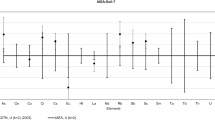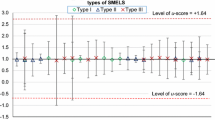Abstract
In the k 0 method of standardisation in neutron activation analysis (k 0-NAA), the ratio of thermal to epithermal neutrons, a value known as f, is fundamental in accurately determining the concentration of elements within the sample. Research into determining this f value via the cadmium ratio method was undertaken for two positions within the 20 MW Open Pool Australian Light water (OPAL) research reactor (Lucas Heights, NSW, Australia). A short irradiation and long irradiation position were assessed via two methods; the conventional cadmium ratio method based on the Høgdahl formalism, with f values of 2,666 ± 255 and 1,538 ± 258 being calculated respectively for the short and long positions, and an ASTM-INVAP-based cadmium ratio method, which allows for the higher neutron temperature of OPAL to be accounted for, with f values of 3,057 ± 318 and 1,755 ± 312 being calculated respectively. These values were validated by analysis of NIST standard reference materials (SRM™), with good agreement between experimental values and reference and literature values being observed, showing the accuracy and suitability of these values for OPAL. Additionally, the high values of f shown endorse the strength of performing k 0-NAA at OPAL. This manuscript publishes the first values of f from OPAL and provides a detailed description of the method employed.



Similar content being viewed by others
References
De Corte F, Simonits A, Hoste J (1975) Single comparator methods in reactor neutron activation analysis. J Radioanal Nucl Chem 24:31–46
Simonits A, De Corte F, Hoste J (1976) Zirconium as a multi-isotopic flux ratio monitor and a single comparator in reactor-neutron activation analysis. J Radioanal Chem 31:467–486
Greenberg RR, Bode P, De Nadai Fernandes EA (2011) Neutron activation analysis: a primary method of measurement. Spectrochim Acta Part B 66(3–4):193–241
Bennett JW (2008) Commissioning of NAA at the new OPAL reactor in Australia. J Radioanal Nucl Chem 278(3):671–673
Ramakrishna VVS, Acharya RN, Reddy AVR, Garg AN (2001) Use of gold as monostandard for the determination of elemental concentrations in environmental SRMs and Ganga river sediments by the k 0 method. Appl Radiat Isot 55(4):595–602
De Corte F, Simonits A, Hoste J, De Wispelaere A (1987) Accuracy and applicability of the k 0-standardization method. J Radioanal Nucl Chem 113:145–161
Brockman JD, Peters NJ, Roberson JD (2009) Variation in k 0 neutron flux parameters after replacement of the beryllium reflector and graphite wedge at the University of Missouri Research Reactor. J Radioanal Nucl Chem 282:41–44
Alghem L, Ramdhane M, Khaled S, Akhal T (2006) The development and application of k 0-standardization method of neutron activation analysis at Es-Salam research reactor. Nucl Instrum Methods Phys Res Sect A 556(1):386–390
Thermal neutron flux measurement by activation analysis-comm. procedure; 10 Annex 1: The Cadmium Difference Method (2006) Australian Nuclear Science and Technology Organisation/INVAP
E262-03 Standard test method for determining thermal neutron reaction and fluence rates by radioactivation techniques. American Society for Testing and Materials (ASTM) International
Chilian C, Chambon R, Kennedy G (2010) Neutron self-shielding with k 0-NAA irradiations. Nucl Instrum Methods Phys Res Sect A 622(2):429–432
Trkov A, Zerovnik G, Snoj L, Ravnik M (2009) On the self-shielding factors in neutron activation analysis. Nucl Instrum Methods Phys Res Sect A 610(2):553–565
Tables for Neutron Activation Analysis. (2006) Columbia
Ehmann WD, Vance DE (1991) Radiochemistry and nuclear methods of analysis. Wiley, New York
Certified Reference Material IRMM-530RC Certificate of Analysis (2008) Institue for Reference Materials and Measurements
Kucera J, De Corte F, Simonits A, Bellemans F (1997) In: Proceedings of the 2nd International k 0 Users Workshop Ljubljana, Slovenia, p 15
Certificate of Analysis AU005137/14 (2011) Goodfellow Cambridge Limited
Cadmium Shielding Products. (2008) Shieldwerx™, 4135 Jackie Rd, Rio Rancho, New Mexico, USA. http://www.shieldwerx.com/cadmium.html. Accessed 10 Oct 2012
HyperLab (2009) HyperLab Software. Budapest, Hungary
McGarry ED (1964) Measurements of the resonance neutron self-shielding in gold wires. Trans Am Nucl Soc 7:86
Kayzero for Windows for reactor neutron activation analysis (NAA) using k 0 standardization method, Version 2 Users Manual (2005) DSM Research R94-11492, Geleen, The Netherlands
De Bièvre P, Günzler H (2005) Traceability in chemical measurement. Springer, Germany
Bennett JW, Grave P, Stopic AJ (2012) Establishing a basis for nuclear archaeometry in Australia using the 20 MW OPAL research reactor. J Radioanal Nucl Chem 291:13–17
Akaho EHK, Nyarko BJB (2002) Characterization of neutron flux spectra in irradiation sites of MNSR reactor using the Westcott-formalism for the k 0 neutron activation analysis method. Appl Radiat Isot 57(2):265–273
Barbos D, Paunoiu C, Roth C (2010) Determination of a and f parameters at the 14-MW TRIGA reactor at Pitesti, Romania. Nucl Instrum Methods Phys Res Sect A 622(2):425–428
Brockman JD, Robertson JD (2009) Analysis of k 0 neutron activation analysis at the University of Missouri Research Reactor. Appl Radiat Isot 67(6):1084–1088
Acknowledgments
The authors wish to thank J.W. Bennett and A. Stopic from the Australian Nuclear Science and Technology Organisation (ANSTO) for their extensive help on this project. This research was funded by an Australian Institute of Nuclear Science and Engineering (AINSE) grant 11/012. R. Popelka-Filcoff acknowledges the Australian Institute of Nuclear Science and Engineering (AINSE) Fellowship. R. Murrie acknowledges the Defence Scholarship from the Department of Further Education, Employment, Science and Technology of the Government of South Australia, and the Max and Bette Mendelson Foundation Scholarship from the City of West Torrens Council.
Author information
Authors and Affiliations
Corresponding author
Electronic supplementary material
Below is the link to the electronic supplementary material.
Rights and permissions
About this article
Cite this article
Murrie, R.P., Quinton, J.S. & Popelka-Filcoff, R.S. Determination of the f parameter for k 0-neutron activation analysis at the Australian 20 MW OPAL research reactor. J Radioanal Nucl Chem 298, 77–86 (2013). https://doi.org/10.1007/s10967-013-2542-7
Received:
Published:
Issue Date:
DOI: https://doi.org/10.1007/s10967-013-2542-7




